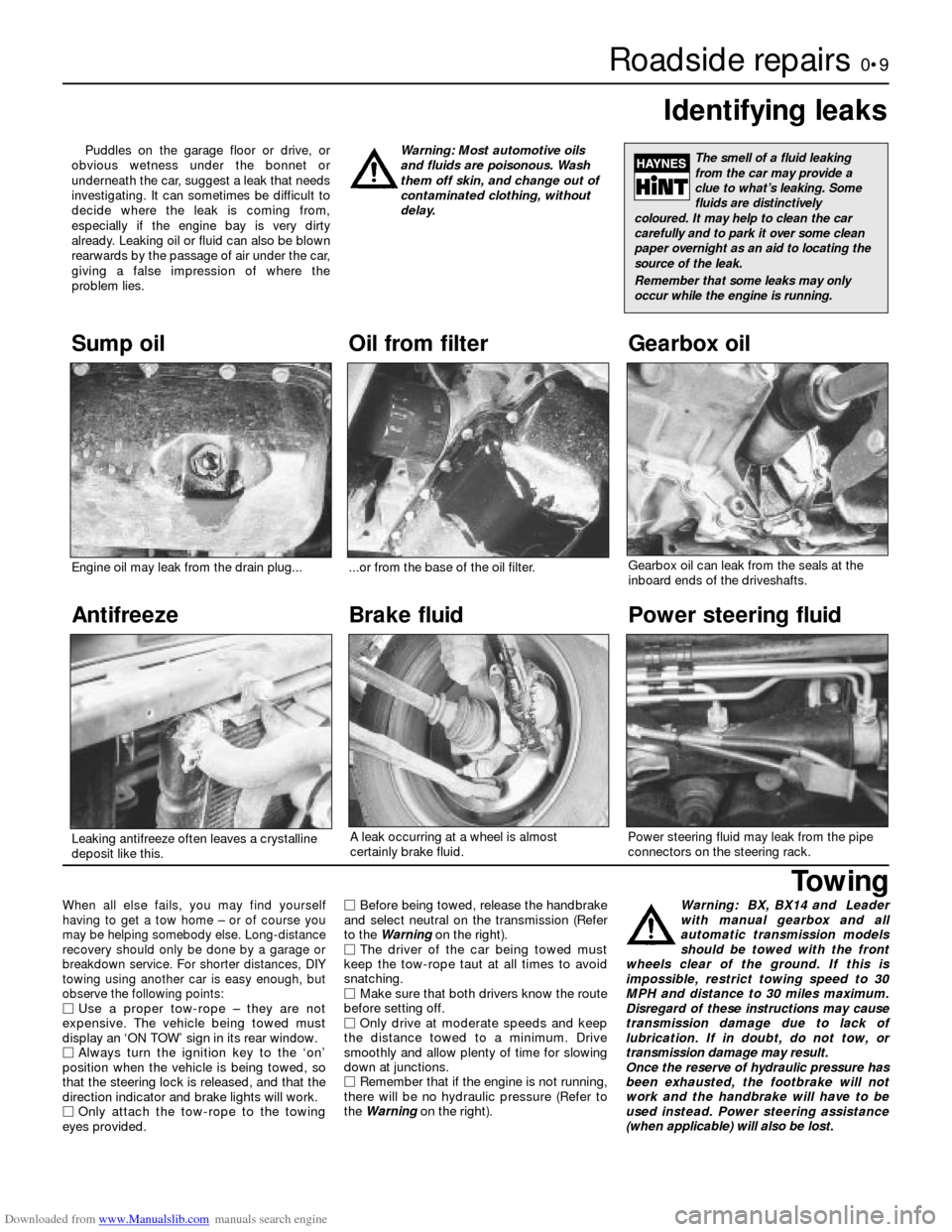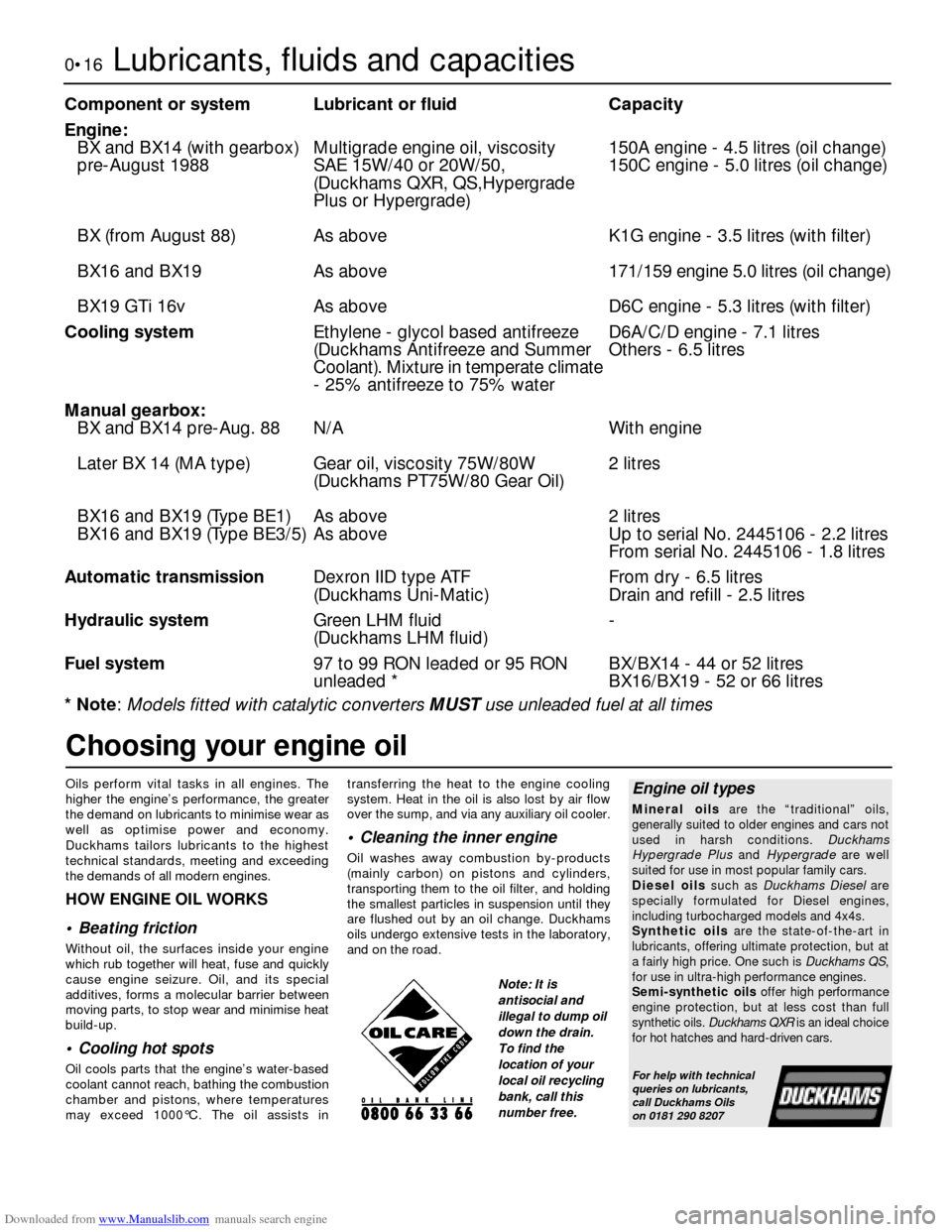gearbox Citroen BX HATCHBACK 1987 2.G Workshop Manual
[x] Cancel search | Manufacturer: CITROEN, Model Year: 1987, Model line: BX HATCHBACK, Model: Citroen BX HATCHBACK 1987 2.GPages: 16, PDF Size: 0.47 MB
Page 3 of 16

Downloaded from www.Manualslib.com manuals search engine REPAIRS & OVERHAUL
Engine and Associated Systems
150 engine repair procedures Page2A•1
171 and 159 engine repair procedures Page2B•1
K1G engine repair procedures Page2C•1
D6C engine repair procedures Page2D•1
Cooling, heating and air conditioning systems Page3•1
Fuel and exhaust systems - carburettor models Page4A•1
Fuel and exhaust systems - Bosch LE3 Jetronic injection Page4B•1
Fuel and exhaust systems - Motronic injection Page4C•1
Fuel and exhaust systems - Magneti Marelli injection Page4D•1
Ignition system - carburettor models Page5A•1
Ignition system - fuel injection models Page5B•1
Starting and charging systems Page5C•1
Transmission
ClutchPage6•1
Manual gearboxPage7A•1
Automatic transmission Page7B•1
DriveshaftsPage8•1
Brakes and Suspension
Hydraulic systemPage9•1
Braking systemPage10•1
Suspension and steering Page11•1
Body Equipment
Bodywork and fittingsPage12•1
Body electrical systems Page13•1
Wiring DiagramsPage13•16
REFERENCEDimensions and weights PageREF•1
Conversion factorsPageREF•2
Buying spare partsPageREF•3
Vehicle Identification PageREF•3
General repair procedures PageREF•4
Jacking and vehicle support PageREF•5
Tools and working facilities PageREF•6
MOT test checksPageREF•8
Fault findingPageREF•12
Glossary of technical terms PageREF•19
IndexPageREF•23
Contents
Page 4 of 16

Downloaded from www.Manualslib.com manuals search engine The Citroën BX was introduced in France in October of 1982 and
became available in the UK in September 1983. The original models
available in the range were the BX, BX 14 E, BX 14 RE, BX 16 RS and BX
16 TRS. The types of engine, transmission and equipment fitted being
dependent on the model and the body design being that of a Hatchback.
For the 1985 model year, the BX 19 GT was made available for the
driver requiring a higher performance model. Also in 1985, the BX
Leader replaced the BX and BX 14 models, the Leader being fitted with
the same engine and transmission as the BX 14. In the second half of
1985 the Estate was introduced, two versions being available, the BX
16 RS Estate and the BX 16 TRS Estate.
Changes for the 1987 model year included the introduction of the BX
16 RE Hatchback, the BX 19 GTi (fuel injection and ABS braking), the
BX 19 GTi 16v (16 valve engine) and the replacement for the BX 19 GT,
the BX 19 TRS. Also, a BX 19 TRS Estate fitted with automatic
transmission became available. The facia and instruments were
modified on all models, with round instruments being used. Other
aesthetic improvements were made to improve the external
appearance of certain models.For the 1988 model year, all BX 14 models were equipped with the
K1G engine with 2CA type 4 or 5-speed manual gearbox.
For the 1989 model year, BX 16 and BX 19 models were equipped
with the BE3 5-speed manual gearbox to replace the earlier BE1 5-
speed type.
In early 1990, BX 19 TZi Hatchback and Estate models became
available, these being equipped with catalytic converters.
In late 1992, BX 16 TXi catalytic converter equipped Hatchback and
Estate models were added to the range.
On all models, the engine and transmission is mounted transversely
and drives the front wheels through two driveshafts. The transmission
available (depending on model type) is a 4 or 5-speed manual gearbox
or a 4-speed automatic unit.
All models are extremely comfortable to ride in, thanks to the
hydropneumatic suspension and luxurious interior trim. The unique
design suspension is self-levelling and the ride height is maintained
automatically over all road conditions. A ground clearance lever inside
the car may be used to adjust the ride height when travelling over
rough ground, this also makes changing a roadwheel much simpler.
Your Citroën BX Manual
The aim of this Manual is to help you get the best value from your
vehicle. It can do so in several ways. It can help you decide what work
must be done (even should you choose to get it done by a garage),
provide information on routine maintenance and servicing, and give a
logical course of action and diagnosis when random faults occur.
However, it is hoped that you will use the Manual by tackling the work
yourself. On simpler jobs it may even be quicker than booking the car
into a garage and going there twice, to leave and collect it. Perhaps
most important, a lot of money can be saved by avoiding the costs a
garage must charge to cover its labour and overheads.
The Manual has drawings and descriptions to show the function of
the various components so that their layout can be understood. Then
the tasks are described and photographed in a clear step-by-step
sequence.
Acknowledgements
Thanks are due to Champion Spark Plug who supplied the illustrations
showing spark plug conditions, and to Duckhams Oils, who provided
lubrication data. Certain other illustrations are the copyright of Citroën
(UK) Limited and are used with their permission. Thanks are also due to
Sykes-Pickavant Limited, who supplied some of the workshop tools,
and to all those people at Sparkford who helped in the production of
this Manual.
We take great pride in the accuracy of information given in this
manual, but vehicle manufacturers make alterations and design
changes during the production run of a particular vehicle of which
they do not inform us. No liability can be accepted by the authors
or publishers for loss, damage or injury caused by any errors in, or
omissions from the information given.
0•4Introduction
The Citroën BX Team
Haynes manuals are produced by dedicated and
enthusiastic people working in close co-operation. The
team responsible for the creation of this book included:
Authors Ian Coomber
Christopher Rogers
Sub-editors Sophie Yar
Carole Turk
Editor & Page Make-up Steve Churchill
Bob Jex
Workshop manager Paul Buckland
Photo Scans John Martin
Paul Tanswell
Steve Tanswell
Cover illustration & Line Art Roger Healing
We hope the book will help you to get the maximum
enjoyment from your car. By carrying out routine
maintenance as described you will ensure your car’s
reliability and preserve its resale value.
Citroën BX 19 GTiCitroën BX 16 TRS
Page 9 of 16

Downloaded from www.Manualslib.com manuals search engine Roadside repairs0•9
When all else fails, you may find yourself
having to get a tow home – or of course you
may be helping somebody else. Long-distance
recovery should only be done by a garage or
breakdown service. For shorter distances, DIY
towing using another car is easy enough, but
observe the following points:
MUse a proper tow-rope – they are not
expensive. The vehicle being towed must
display an ‘ON TOW’ sign in its rear window.
MAlways turn the ignition key to the ‘on’
position when the vehicle is being towed, so
that the steering lock is released, and that the
direction indicator and brake lights will work.
MOnly attach the tow-rope to the towing
eyes provided.MBefore being towed, release the handbrake
and select neutral on the transmission (Refer
to the Warningon the right).
MThe driver of the car being towed must
keep the tow-rope taut at all times to avoid
snatching.
MMake sure that both drivers know the route
before setting off.
MOnly drive at moderate speeds and keep
the distance towed to a minimum. Drive
smoothly and allow plenty of time for slowing
down at junctions.
MRemember that if the engine is not running,
there will be no hydraulic pressure (Refer to
the Warningon the right).Warning: BX, BX14 and Leader
with manual gearbox and all
automatic transmission models
should be towed with the front
wheels clear of the ground. If this is
impossible, restrict towing speed to 30
MPH and distance to 30 miles maximum.
Disregard of these instructions may cause
transmission damage due to lack of
lubrication. If in doubt, do not tow, or
transmission damage may result.
Once the reserve of hydraulic pressure has
been exhausted, the footbrake will not
work and the handbrake will have to be
used instead. Power steering assistance
(when applicable) will also be lost.
Towing
Puddles on the garage floor or drive, or
obvious wetness under the bonnet or
underneath the car, suggest a leak that needs
investigating. It can sometimes be difficult to
decide where the leak is coming from,
especially if the engine bay is very dirty
already. Leaking oil or fluid can also be blown
rearwards by the passage of air under the car,
giving a false impression of where the
problem lies.Warning: Most automotive oils
and fluids are poisonous. Wash
them off skin, and change out of
contaminated clothing, without
delay.
Identifying leaks
The smell of a fluid leaking
from the car may provide a
clue to what’s leaking. Some
fluids are distinctively
coloured. It may help to clean the car
carefully and to park it over some clean
paper overnight as an aid to locating the
source of the leak.
Remember that some leaks may only
occur while the engine is running.
Sump oil Gearbox oil
Brake fluid Power steering fluidOil from filter
Antifreeze
Engine oil may leak from the drain plug......or from the base of the oil filter.
Leaking antifreeze often leaves a crystalline
deposit like this.Gearbox oil can leak from the seals at the
inboard ends of the driveshafts.
A leak occurring at a wheel is almost
certainly brake fluid.Power steering fluid may leak from the pipe
connectors on the steering rack.
Page 16 of 16

Downloaded from www.Manualslib.com manuals search engine 0•16Lubricants, fluids and capacities
Component or system Lubricant or fluid Capacity
Engine:
BX and BX14 (with gearbox) Multigrade engine oil, viscosity 150A engine - 4.5 litres (oil change)
pre-August 1988 SAE 15W/40 or 20W/50, 150C engine - 5.0 litres (oil change)
(Duckhams QXR, QS,Hypergrade
Plus or Hypergrade)
BX (from August 88) As above K1G engine - 3.5 litres (with filter)
BX16 and BX19 As above171/159 engine 5.0 litres (oil change)
BX19 GTi 16v As above D6C engine - 5.3 litres (with filter)
Cooling systemEthylene - glycol based antifreeze D6A/C/D engine - 7.1 litres
(Duckhams Antifreeze and Summer Others - 6.5 litres
Coolant). Mixture in temperate climate
- 25% antifreeze to 75% water
Manual gearbox:
BX and BX14 pre-Aug. 88 N/A With engine
Later BX 14 (MA type) Gear oil, viscosity 75W/80W 2 litres
(Duckhams PT75W/80 Gear Oil)
BX16 and BX19 (Type BE1) As above 2 litres
BX16 and BX19 (Type BE3/5) As above Up to serial No. 2445106 - 2.2 litres
From serial No. 2445106 - 1.8 litres
Automatic transmissionDexron IID type ATF From dry - 6.5 litres
(Duckhams Uni-Matic) Drain and refill - 2.5 litres
Hydraulic systemGreen LHM fluid -
(Duckhams LHM fluid)
Fuel system97 to 99 RON leaded or 95 RON BX/BX14 - 44 or 52 litres
unleaded * BX16/BX19 - 52 or 66 litres
* Note: Models fitted with catalytic converters MUSTuse unleaded fuel at all times
Oils perform vital tasks in all engines. The
higher the engine’s performance, the greater
the demand on lubricants to minimise wear as
well as optimise power and economy.
Duckhams tailors lubricants to the highest
technical standards, meeting and exceeding
the demands of all modern engines.
HOW ENGINE OIL WORKS
• Beating friction
Without oil, the surfaces inside your engine
which rub together will heat, fuse and quickly
cause engine seizure. Oil, and its special
additives, forms a molecular barrier between
moving parts, to stop wear and minimise heat
build-up.
• Cooling hot spots
Oil cools parts that the engine’s water-based
coolant cannot reach, bathing the combustion
chamber and pistons, where temperatures
may exceed 1000°C. The oil assists intransferring the heat to the engine cooling
system. Heat in the oil is also lost by air flow
over the sump, and via any auxiliary oil cooler.
• Cleaning the inner engine
Oil washes away combustion by-products
(mainly carbon) on pistons and cylinders,
transporting them to the oil filter, and holding
the smallest particles in suspension until they
are flushed out by an oil change. Duckhams
oils undergo extensive tests in the laboratory,
and on the road.
Engine oil types
Mineral oilsare the “traditional” oils,
generally suited to older engines and cars not
used in harsh conditions. Duckhams
Hypergrade Plus and Hypergradeare well
suited for use in most popular family cars.
Diesel oilssuch as Duckhams Dieselare
specially formulated for Diesel engines,
including turbocharged models and 4x4s.
Synthetic oilsare the state-of-the-art in
lubricants, offering ultimate protection, but at
a fairly high price. One such is Duckhams QS,
for use in ultra-high performance engines.
Semi-synthetic oilsoffer high performance
engine protection, but at less cost than full
synthetic oils. Duckhams QXRis an ideal choice
for hot hatches and hard-driven cars.
For help with technical
queries on lubricants,
call Duckhams Oils
on 0181 290 8207
Choosing your engine oil
Note: It is
antisocial and
illegal to dump oil
down the drain.
To find the
location of your
local oil recycling
bank, call this
number free.